When a child’s teeth are cut, it’s not just the crumb due to severe itching of the gums, but also to all households, since the children become very moody, sleep poorly at night, and do not let their fists out of their mouth. Unpleasant sensations from cutting teeth help brighten up special painkillers gels and special teethers for teeth. Teethers also help to form the correct bite, improve and develop fine motor skills of the hands and prepare the child for the chewing process.
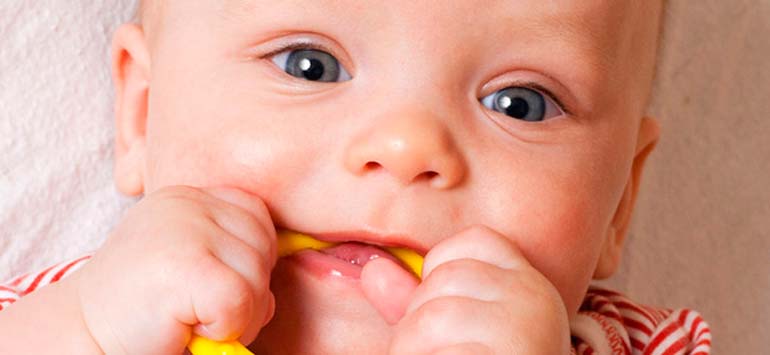
The main purpose of teethers is gum massage. Massage helps to reduce discomfort in the gums and causes a rush of blood to the massaged area, accelerating the process of biting the tooth. Despite the fact that the teething goal is the same, they themselves are very different from each other. Different types of teethers are designed for different ages and can serve different additional purposes.
If you are going to buy a teether for your child, then you definitely need to think about the comfort and health of your beloved child. The fact is that a bad low-quality product is likely to cause an allergy in the child, and an improperly selected model will simply lie idle. How to avoid such mistakes when choosing? Below you will learn about some important nuances.
What are teethers
Material. Teethers are made of silicone, latex, can be made of plastic, thermoplastic rubber, wooden. The latex ones are considered the softest, and all because they are more elastic. However, the disadvantage of such a product is that it wears out faster. Make sure that the solid product does not contribute to the formation of a malocclusion - it must have an anatomical shape.
Appointment. Manufacturers take into account that the child’s teeth are cut sequentially, and produce different types of teethers, which are necessary for a certain stage of tooth growth and their location:
- Stage No. 1 - the product relieves pain when the front lower teeth appear;
- Stage No. 2 - the product is intended for the upper front teeth;
- Stage No. 3 - lateral and distant teeth;
- Universal. Suitable in all cases.
For the smallest (up to 3 months) there are teethers that help massage the gums and penetrate the upper and lower teeth (incisors). From 4 to 6 months - options for teething premolars. From six months - for the posterior teeth (molars).
There are also universal species that perform all of the above functions. In any case, you can always read the relevant information on the product packaging.
First Teething Article – https://kid.htgetrid.com/en/razvitie-rebenka-do-goda/u-rebenka-rezhutsya-pervyie-zubyi.html
Safety. Choosing the right model for your baby, always pay attention to its excessively hard parts, as they can lead to injury. Do not take teasers that are too bright with an “acidic” tint - dyes in their composition may be of poor quality and will lead to poisoning or allergic reactions due to their toxicity. Of course, the product must be durable, so that the baby could not bite off part of it and swallow it.
Shape and size. Do not buy too large or small teething teeth, as they are uncomfortable for the child, and he simply abandons them. Both the shape and size of the product should be suitable for the baby's mouth, in addition, the teether should lie well on the gums. As for pimples, tubercles and other irregularities, this is quite normal - the child usually “scratches” their teeth about them. Typically, the teether is made in the shape of a ring or other geometric shapes. Often manufacturers, trying to attract the attention of children, create products in the form of animals or fruits.
There are also tiny brush heads that parents put on their finger and massage the baby’s gums. In addition, the market offers teethers with a filler (plain water or a special gel), due to which pain symptoms are alleviated and swelling is mitigated, and battery-powered options with gum stimulation - when you turn on the device starts to vibrate, which improves the blood microcirculation in the gums.
Watch the video
Kinds
- Silicone / Latex. Classic teething teeth. They can be in the form of any geometric figures. Intended for the child to "scratch" their inflamed gums about it. Silicone teethers are very soft, so they are best suited for babies 3 to 5 months old, that is, when the teeth just begin to cut. Features of silicone are such that dust, pet hair and various small household rubbish very easily stick to this material. This means that parents need to diligently monitor the cleanliness of the silicone teether;
- Fingertip with brush.Mom puts the product on her finger and massages the peanut gum. By the way, teething nozzles are not to all children’s liking, despite the fact that they finger their fingers with pleasure;
- Teething rattles and teething toys. There are a lot of options for such teethers. The teether in this case is an element of a rattle, a plastic or even a soft toy. As a rule, these elements are made of soft plastic or rubber; they can have different textures for an additional massage effect. The calculation in this case is that children like to put all their toys into their mouths. An attempt to combine business with pleasure is often successful. Teethers are suitable for babies older than six months who are already confidently manipulating objects;
- Cooling with water or gel. Such teethers are made of rubber and filled with distilled water or a special gel. They can be in the form of abstract figures or animals. As a rule, there is always a pen so that it is convenient for the child to hold this useful toy. Before giving the teether to the baby, it needs to be cooled. To do this, he must lie down in the main chamber of the refrigerator for no more than an hour. Cold slightly anesthetizes the gums. The contents of such a teether is safe for the baby, so you can not worry about the crumbs biting through the rubber. Because of the filler, such teethers are quite heavy, so they are suitable for older children. Famous brands - Nuby, Avent, Bright Starts, Nuk;
- With vibration. It looks like an ordinary rubber teether, but if you bite it lightly, vibration is turned on. These teethers are equipped with a simple mechanism and battery. Vibration enhances the massage effect of the teether, and the process itself is interesting for babies;
- Teethers. They can be made of plastic, rubber, silicone.The point is that in their form, these teethers resemble pacifiers. The nipple itself, designed for biting, can have different relief projections, it can be voluminous or flat. Teethers are suitable for babies who are "friends" with a dummy;
- Teether books. The book allows you to occupy the baby and scratch your teeth 🙂
Photo gallery (clickable)
Komarovsky about teething
Recommendations for selection and use
[sc: ads]
- The teether should be safe for the baby. In this case, a guarantee of security will be a credible manufacturer that complies with all requirements for the production of children's goods.
- Choose a teether based on the age and capabilities of the crumbs. Regardless of the type of teether, it should be “proportionate” to the child: it fits easily in his pen and mouth. In addition, the baby should understand what to do with this subject, and it is interesting to “use” it. So, for a three-month-old baby, a complicated toy with teethers may still be inaccessible, and for a one-year-old a simple rattle-teether is no longer interesting.
- Try different teething models within your child’s age. You can never tell in advance which teether your baby will like.
- Do not forget about the rules of hygiene and regularly treat the teether.
- Do not be discouraged if your baby prefers his finger or any other toy to all new-fashioned teethers. The most important thing is that the child can get relief during teething.
Not always parents at all manage to teach the baby to bite teething. Some offer children drying, hard vegetables, such as carrots. If the baby has not yet received complementary foods, it is not advisable to use food for teething. In the end, you can just temporarily increase control over the cleanliness of all the toys and pens of the baby: let him bite any rattle or his fist.
We also read:
- Teething problems
- How to relieve teething pain: 5 effective tips. Video consultation of specialists, plus personal experience of mothers
- First aid for teething in the baby: TOP - 7 gels for gums
- When can small children start brushing their teeth (how to teach a child to brush his teeth).
Svetlana Vakulenko tells how to choose a teether

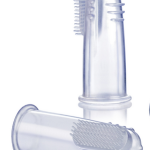
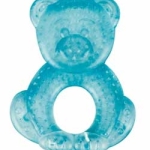
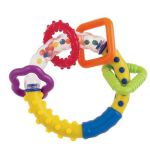
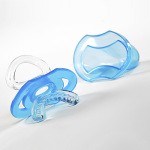
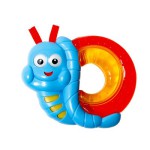
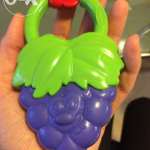
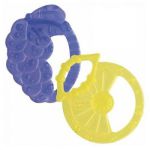
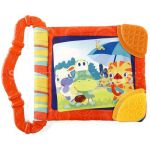


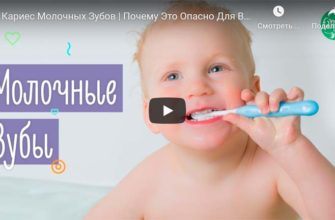
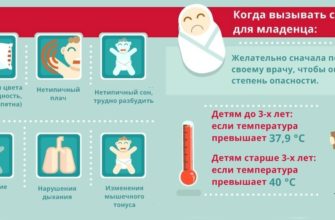




For my first-born, I chose, cut through inexpensively, but I looked so that the material from which it was made was of high quality, and I took it only in large stores so as not to fall for a fake. Son constantly played with him.
From my own experience I can say that erupt from latex is better, it is more elastic and my daughter was crazy about him, at first she sucked, then she began to gnaw with great enthusiasm.
When the child began to cut his teeth and he began to pull everything in his mouth, I bought him a teether. I bought in a regular pharmacy. He looked like an ordinary nipple, but instead of a pen was just a teether. Made very high quality, made of silicone. The child liked this toy.
I have a great experience of using, as I am the mother of four children. Most of all we liked teething toys. You can gnaw deeply and cheerfully. The cooling teethers with water (gel) somehow didn’t take root in us. We often forgot to put them in the refrigerator, and the water became cloudy over time - pleasant is not enough. But I did not see teething with vibration, probably the kids really like them, and the gums are well massaged.
Since our teeth are a sore subject. The husband has acquired a whole bunch of all kinds of teething. From simple ones to those that freeze. And even a set of teethers for each group of teeth. The usual star-shaped one helped best and the fingertip with bristles also really helped out.
We are 5 months old. We bought the simplest teether from the Kurnosiks in the form of a figure eight. Something the little son does not want to drag him into his mouth at all. And he drags the rest with great interest into his mouth. All rattles, toys, diapers, a blanket, fists and even a horizontal bar in a stroller are used, but he completely refuses a teether. Turn it a bit in the hands and throws it ... And what can we do about it, I won’t know ...
To help the child when his teeth are cut and itched, we bought the Fresh Relax Chicco teether. We bought it when my daughter was 4 months old. The teether is very pleasant to the touch, as it is made of soft plastic and hard rubber. The upper part is a cooling ring with pimples, which just helps with pain. The lower part is made in the form of a handle, which is convenient to hold with small handles, and you can also bite it. Before giving the baby a teether, it must be put in the refrigerator for 5 - 10 minutes. (just not in the freezer). Putting in the cold can be an unlimited number of times. Teether - a very necessary purchase for a child! I advise everyone !!!
We had simple teethers. Some worries with them. First you need to find where his child got into a mess, then boil it. Now they bought a teether Wuffy in the form of a mitten, she dresses on the handle, and the teether is attached at the top. The roxy company released such a cool thing, there is a video in YouTube. Look who is interested)